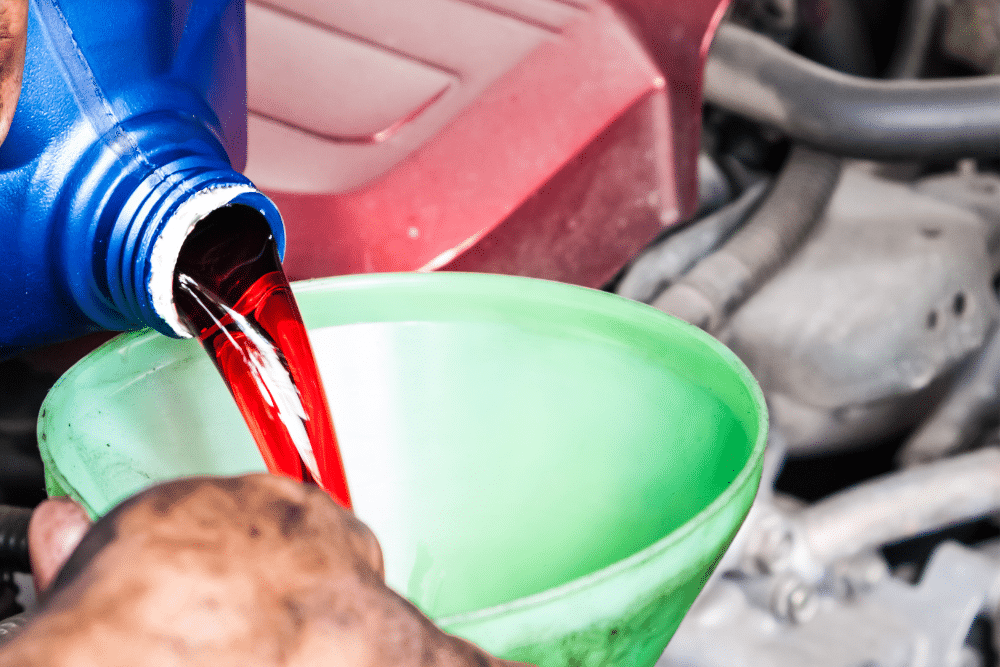Slipping gears, rough shifts, or a burning smell? These are signs your transmission fluid may need to be replaced. At Next Level Auto Services, we help drivers in Mequon, North Milwaukee, and Menomonee Falls catch these issues early, before they become costly repairs.
In this blog, you’ll learn what transmission fluid does, why it’s essential to your car’s performance, and the top signs it’s overdue for replacement. We’ll also explain how to spot leaks, what bad fluid looks like, and why choosing the right type matters, especially if you drive a Honda, BMW, or other modern vehicle.
1. Slipping Gears: Your First Major Red Flag
If your vehicle unexpectedly changes gears or has trouble staying in gear, that’s a classic sign of bad transmission fluid. Low fluid levels or degraded fluid can cause a loss of hydraulic pressure, making it hard for the transmission to operate correctly.
Why It Happens:
- Fluid is burned, contaminated, or leaking
- Hydraulic pressure drops
- Gears can’t engage or hold properly
Slipping gears are not just annoying, they’re dangerous. If your car can’t hold the right gear, it can hesitate or surge while driving.
2. Delayed or Rough Shifting
Are your gear changes taking longer than usual? Or do you feel a jolt when shifting from park to drive? These symptoms are often tied to degraded or dirty transmission fluid.
You might notice:
- A delay before the vehicle moves after shifting
- A clunk or jolt when changing gears
- Hesitation when accelerating
This usually means the fluid has lost its viscosity or is filled with debris. It can no longer provide the pressure or lubrication your transmission needs.
3. Unusual Noises While Driving
Hearing whining, humming, or grinding sounds? These are all possible signs of internal transmission wear, and often, the culprit is old or insufficient fluid.
Sounds to watch for:
- Whining in neutral – A high-pitched whining noise, while your vehicle is in neutral, could point to worn bearings or low transmission fluid that’s struggling to lubricate internal components.
- Grinding during gear changes – If you hear grinding when shifting, it may indicate that the fluid isn’t providing enough protection between gears, allowing metal parts to clash.
- Buzzing or humming at highway speeds – Persistent humming or buzzing at higher speeds can signal that the transmission is under stress due to old, contaminated, or low fluid.
Contaminated fluid can’t protect components from friction, so parts begin to grind together. The sooner you act, the more you can prevent internal damage.
4. Transmission Overheating
Transmission fluid helps manage heat. When it’s dirty or low, the system can’t cool itself properly, causing overheating and further breakdown of the fluid.
Symptoms of overheating:
- Burning smell from under the hood
- Transmission warning lights
- Higher-than-normal engine temperatures
Once overheating starts, it becomes a vicious cycle: hot fluid degrades faster, which leads to more heat and eventually, transmission failure.
5. Leaking Fluid: Easy to Spot, Expensive to Ignore
Spotting a red or brown puddle under your car? That’s a sign of a leak and a serious warning that your transmission is running on borrowed time.
Transmission fluid leak signs:
- Red, brown, or dark fluid under the vehicle
- Oily or rancid-smelling residue
- Low fluid levels when checked with the dipstick (If your car has one. Most modern cars have sealed transmissions with no external dipstick).
Leaks can come from seals, hoses, or the transmission pan. Fixing a leak is much cheaper than replacing a transmission.
Why Transmission Fluid Matters and What Happens When You Ignore It
Transmission fluid isn’t just oil; it’s essential to how your vehicle functions. Whether you drive an automatic, manual, or CVT, this fluid cools and lubricates internal components, creates the hydraulic pressure needed to shift gears (in automatics), and keeps everything moving smoothly. Without it, friction builds, parts wear out, and shifting becomes a struggle.
Many drivers assume transmission fluid doesn’t need attention until there’s a problem, but by then, the damage may already be done. Staying on top of fluid maintenance helps prevent overheating, gear slipping, internal component wear, and costly rebuilds or replacements. At Next Level Auto Services, we educate our clients in Mequon, North Milwaukee, and Menomonee Falls on how routine fluid care protects their investment and keeps their car shifting like it should. Prevention truly is the best and least expensive option.
What Transmission Fluid Should Look and Smell Like
Checking your fluid is a quick way to know if something’s wrong. Transmission fluid should be:
- Bright red or pink when fresh
- Clear and slightly sweet-smelling
- Not burnt or gritty
If it’s dark, smells like burnt toast, or feels sludgy, it’s time for service. Transmission fluids come in all colors (red, blue, green, dark green, brown, and clear).
Flushing vs. Replacing: What You Need to Know
Some shops push a full transmission flush, but that’s not always the right move, especially if your transmission is already struggling.
When a flush might be risky:
- If the fluid is very dark or burnt
- If there are signs of slipping or metal shavings
- If your car has never had fluid service before, and it’s over 100,000 miles
In these cases, a gentle fluid drain and refill may be safer. That’s where our ASE-certified technicians step in to inspect and recommend the right approach.
Using the Right Transmission Fluid Makes a Big Difference
Using the wrong type of fluid is like putting diesel in a gas engine. It can lead to slipping, harsh shifts, or even internal failure. Each vehicle, especially brands like Honda, BMW, or Acura, has unique fluid specs.
At Next Level, we use OEM-grade fluids for every vehicle. For many cars, that means Amsoil synthetic transmission fluid, offering superior heat resistance and performance.
How Often Should You Replace Transmission Fluid?
There’s no one-size-fits-all answer. Manufacturer intervals vary, but a good general rule:
- Automatic transmissions: every 30,000–60,000 miles
- Manual transmissions: every 60,000 miles
- CVTs or Euro vehicles: CVTS (30,000 miles on all; European vehicles (varies on transmission type)
If you drive a BMW, Audi, Honda, Acura, or other vehicle, our team can give you model-specific recommendations.
Our Process at Next Level Auto Services
We don’t just swap fluid and call it done. Here’s what you can expect when you bring your vehicle in:
- Digital Vehicle Inspection (DVI): Full visual report with photos
- OEM diagnostic scan using factory tools
- Fluid condition check and leak inspection
- Honest recommendations: what’s urgent vs. what can wait
- Quality control review: clean handoff with no grease, no mess
You get text-to-pay options, flexible drop-off and pick-up, and a 3-year/36,000-mile warranty for peace of mind.
When to Book Transmission Service
If you notice any of these signs:
- Your car hesitates or jerks when shifting
- You hear whining or buzzing while driving
- There’s a burning smell or red puddle under your vehicle
- Your fluid looks dark, smells burnt, or feels gritty
…it’s time to call a pro.
Frequently Asked Questions About Transmission Fluid
What are the signs my transmission fluid needs to be changed?
Slipping gears, delayed or rough shifting, strange noises (like whining or grinding), and a burning smell are all signs your transmission fluid may be low, dirty, or breaking down.
How often should I replace transmission fluid in a Honda, BMW, or other vehicle?
Most vehicles need a fluid replacement every 30,000–60,000 miles, but it’s important to understand that higher-end brands like Audi and BMW often label their fluid as “lifetime.” In reality, no fluid lasts forever, especially under real-world driving conditions. We recommend having your transmission fluid inspected regularly and serviced based on your vehicle’s condition and driving habits. Our ASE-certified technicians can give you a more accurate recommendation tailored to your specific vehicle.
Can I flush old or burnt transmission fluid?
Not always. If the fluid is severely degraded, a flush could make things worse. Our team will inspect the fluid first and recommend the safest service, whether that’s a flush or a less invasive, careful drain and refill.
What happens if I skip transmission fluid maintenance?
You risk overheating, slipping gears, internal damage, and eventually full transmission failure. A simple fluid service now can save you thousands later.
Schedule Your Transmission Fluid Service Before It’s Too Late
At Next Level Auto Services, we specialize in premium transmission care for Honda, Acura, BMW, Audi, Mercedes, and other high-end vehicles. Our ASE-certified technicians work alongside you, not just under the hood, to help you make informed, confident decisions about your vehicle. We believe in education over upselling and prioritize long-term reliability over quick fixes.
If you’ve noticed slipping gears, delayed shifting, or fluid leaks, now is the time to act. Don’t wait for warning lights or costly repairs. Visit us at 9334 N 107th Street, Ste 100, Milwaukee, WI 53224, conveniently located for drivers in Mequon, North Milwaukee, and Menomonee Falls. Call (414) 206-0100 or schedule your appointment online today and experience automotive care done differently.

